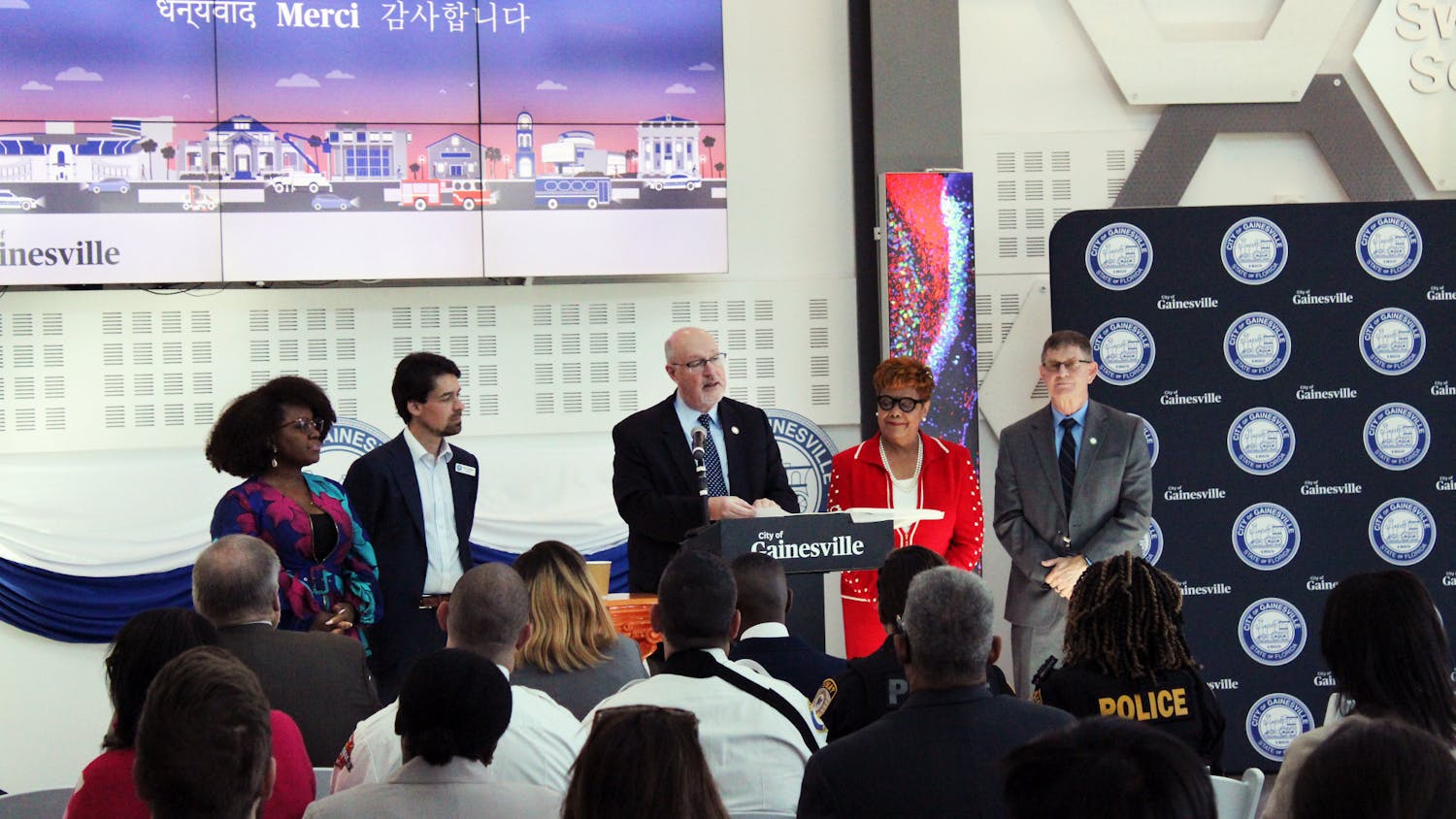Gainesville artist Melanie Peter walked toward an art exhibit as protesters set up their exhibit outside.
Inside, Peter walked past bottles of wine and trays of delicately sliced meats. Outside, resident Maria Parsons lined up bottles of water and a basket of eggs — all contaminated, she said.
The artist went past two security guards and into the gallery. An etching of a skull and crossbones, a jungle-like oil painting and other pieces lined the walls. The signs lining the sidewalk outside also showed skulls and crossbones, but for a different reason.
Peter said the art project inside and the protesters outside represent voices crying for change.
“We all have our different, varied skills,” she said. “I personally can’t do that — going to meetings and thinking on my feet and arguing. But I can paint.”
The art show, “Region 4: Transformation through Imagination,” was created to showcase city artists’ feelings about the history and cleanup of a chemically toxic site in northeast Gainesville called the Cabot-Koppers Superfund site. During the show’s March 2 opening, about 300 people packed into the Thomas Center to see the exhibit and discuss the site. The show will be on display until April 28.
About 30 years ago, the Cabot-Koppers site was deemed environmentally hazardous by the U.S. Environmental Protection Agency. Kids weren’t allowed to play near the area anymore. People were worried that a nearby creek was dangerous, and it was. Cancer concerns still loom.
Since then, residents and local governments have protested — some with letters, some with chants. For the artists, the works in the art project were a form of protest. But for the protesters, the art show didn’t help the situation.
For those living near the Cabot-Koppers Superfund site, listening to roughly 30 years of cleanup negotiations hasn’t been easy.
Some are frustrated. Some are furious. And others say they are happy to see something being done, even if it isn’t all they hoped for.
The exhibit prompted a few residents to put their dissenting emotions on display. The group, which fluctuated between three and five through the afternoon, came armed with arguments against the art project’s intentions and inspirations.
The art show ranged from taped-up paperwork and video testimonies to a branching tree of bones, twigs and mementos.
Peter’s work, an oil painting of a dense, jungle-like creek, hung near the entrance.
Her work has more luscious trees and palm fronds than its inspiration, Springstead Creek, has. She said the creek isn’t the same now that it’s dangerous to drink the water or sink your feet into the cool soil.
“This is my imagination of how it was and could be again,” she said.
While gallery-goers meandered around the pieces quietly, some protesters called out to bystanders as they left the building.
Susan Fairforest, a Gainesville resident, held a sign chastising the EPA, the organization responsible for cleaning up the Superfund site.
She said she decided to protest to get people to pay attention to the big picture of the cleanup plan. The EPA plan mentions removing topsoil from contaminated yards, but there are no stipulations for relocation.
“We’re hoping that people will see the other half of what’s going on, not just the feel-good part,”she said.
The city, with neighborhood-organized Superfund Art Project, used a $24,000 grant from a state cultural affairs division to host the show. The city gave an equal amount to the project by paying for the building to be open during the exhibit and for staff time.
Some protesters didn’t approve of funding an art show when there is an unfulfilled need in the city.
Parsons said she believes available money should first be used to relocate residents from neighborhoods near the site. Some are sick. Others have died. She and other supporters blame the contaminants, such as cancer-causing dioxin, from the Superfund site.
Others disagree with the purpose behind the art show — to show a hopeful scenario in the midst of a bad situation — because they believe the project requirements bordered on censorship.
According to a call to artists, the project was meant to showcase “closure and a positive outcome, not accusation and condemnation.”
Mallory O’Connor, show curator, said there wasn’t any censorship of artists’ works.
But Peter said the art show made a point that artists and activists alike agree upon.
“It’s a powerful statement of what we won’t put up with as people,” she said. “These are alarms in some form or another that we have to clean up or die.”
Contact Meredith Rutland at mrutland@alligator.org.





